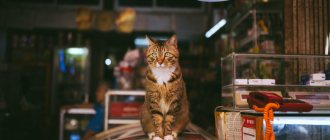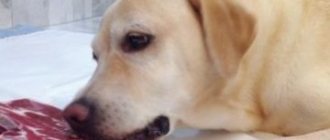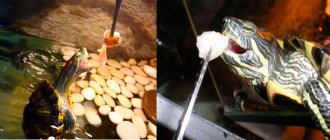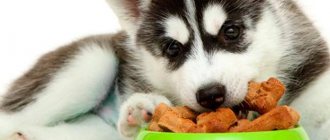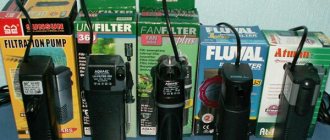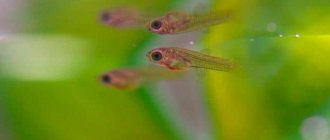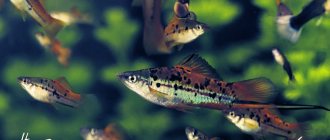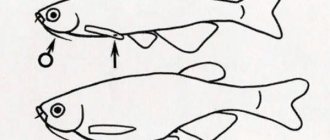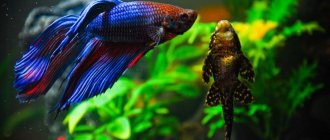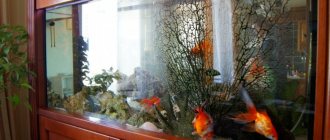Very often in pet stores, aquarium fish sellers hear questions about how and what to feed them. However, the issue of feeding fish is not so simple at first glance, since it is necessary to know exactly the dosage of food per meal.
Proper feeding of the fish will be the key to their health and you will get great pleasure from watching them in the aquarium. Today we will try to outline in detail the basics of proper feeding of aquarium fish.
- Herbivores
Feeding aquarium fish: how many times a day
Beginning aquarists very often overfeed their pets, which has negative consequences. This most often leads to water contamination, which can cause the death of the inhabitants of the aquarium or cause them to become stressed. The harmful consequences that arise boil down to the following aspects:
- Leftover uneaten food decomposes quickly, which causes the release of ammonia.
- Excess food, especially protein ingested by fish, contributes to increased release of ammonia into the water space with waste products. The resulting ammonia in the water can deplete the biological filter. However, the biological filter can adapt and will cope with the increased level of the substance for some time, but the end result will be contamination of the aquarium and the development of various parasites.
So, how often should you feed your aquarium fish? At one meal, they need to be given as much food as they can eat in approximately five minutes. If excess food gets in, it must be removed before decomposition begins in the water space.
A very large number of fish and fry in nature feed continuously, for this reason it is recommended to feed them several times a day in small portions. Maintaining a large aquarium with a variety of aquatic inhabitants will require feeding them 2-3 times a day. An exception to such feeding will be representatives of predatory fish, for which 2-3 meals a day will be enough for one week. When predators are full, they may ignore new food.
When maintaining an aquarium, it is worth considering the fact that some species are nocturnal, as they may skip feeding. It is necessary to very carefully monitor the behavior of the fish when receiving food and promptly respond to loss of appetite.
From the video you will learn how to prepare semolina porridge for fish.
Types of fish
Existing fish can be divided into three types based on their diet: omnivores, herbivores (herbivores) and carnivores (carnivores).
The diet of omnivorous fish consists of both plant and animal foods.
Herbivorous fish , for example, labidochromis, ancistrus and others, feed on algae, duckweed, pieces of cucumbers, zucchini, apples, pumpkins, and lettuce. Vegetables should be doused with boiling water before feeding them to the fish. In general, the diet of this group of fish should include 70% plant foods and 30% protein. Freeze-dried food with plant ingredients will be an excellent food. Live or frozen food is used as protein food: brine shrimp, bloodworms, and coretra.
Carnivorous or predatory fish eat small crustaceans, insects and their larvae, worms, small fish, and shrimp.
Fish also differ in where they eat. There are those that take food mainly from the surface of the water, for example, zebrafish and guppies. Catfish pick up food from the bottom. And there are fish that take food in the water column. But taking into account the small height of the aquarium, most fish, excluding bottom fish, accept food from the entire aquarium, for example, the platie, it will not disdain food both from the surface of the water and the thickness, and from the bottom.
Tetra food: TetraMin flakes, TetraMin Crisps and TetraColor granules
How long can you not feed aquarium fish?
The need of aquarists for a summer vacation reflects a person’s natural desire to rest during the entire working year. However, during such periods the aquarium must be left unattended.
Note: A properly equipped aquarium can survive without human intervention for a certain period of time. Aquarium fish are very hardy creatures and can easily withstand a temporary lack of food.
Before leaving for a long period of time, you should not purchase new fish and plants (to avoid infection of the water area), fry and other small individuals. It is also worth reducing the dosage of food given and completely eliminating foods that pollute water from the diet. The fish will eat only the portion they need, and the remainder will begin to spoil the quality of the water. It is imperative to clean all aquarium equipment and refresh the water by replacing 1/3 of the total volume. It is not recommended to leave sick fish for a long time in a community aquarium.
Under such conditions, the fish can remain without feeding for 7-10 days, depending on the species.
How many days can fish live without food?
There are situations when you need to leave for several days, but there is no one to leave the fish with. This is where the question arises, how many days can the fish live without feeding?
Before leaving, thoroughly siphon the soil and replace 30% of the aquarium water with fresh water. A few weeks before departure, do not buy new fish, so as not to introduce an infection into the aquarium. Never leave healthy and sick fish together. Before leaving, you can feed your pets a little, but do not overfeed. If you do everything correctly, the fish will be able to live in the aquarium without human intervention for 7 to 10 days.
If you are leaving for a little longer, buy an automatic feeder. The principle of its operation is as follows: pour dry food into the drum (pellets, chips, tablets, the device instructions indicate which types of food are suitable), set an electronic or mechanical timer, with which you program the frequency of feeding and portion size, everything is ready. Then the drum rotates around its axis at a set time and food pours into the aquarium through the slots.
What to feed aquarium fish if there is no food
There are times in life when you suddenly run out of special food and you need to look for an urgent solution to the problem. However, there are ways to feed your pets by using the following tips (Figure 7):
- Earthworms: Large aquarium specimens are very willing to eat earthworms, but they must be thoroughly washed and crushed before dispensing. You should give the fish only the amount they need to completely satisfy their hunger.
- Raw meat without streaks of fat can be eaten in the absence of live food. Raw meat should be scraped off with a knife and given to aquarium pets only in this form.
- Cereals, especially buckwheat or semolina, as well as wheat porridge, are very readily eaten by all types of carp and labyrinth fish. However, such products should only be given as a last resort. The cereal must be boiled until it becomes a thick porridge, then rinsed under a stream of cold water and only after all the mucus has disappeared, strain through a sieve. You can store it in any cool place.
- Non-live food. This includes: dried daphnia, egg yolk, bloodworms (cut, dried and frozen), raw or dried meat, porridge, etc. Such feeds must be used with extreme caution, as they quickly decompose and begin to spoil the water.
Figure 7. Additional food for fish: 1 - earthworms, 2 - raw meat, 3 - semolina porridge, 4 - daphnia
BJU and vitamins
Aquarium housing deprives fish of the ability to regulate their food intake, as they do in their natural habitat. This creates the possibility of nutritional deficiencies.
The nutritional needs of different fish are very different. Some species consume minerals through the gills, while others need large amounts of vitamin C and unsaturated fatty acids. For some, the required amount of food per day hovers around 3.8 mg per gram of body weight (blue neons), while for others, such as goldfish, it is 25 mg.
Proteins and amino acids
To varying degrees, fish need protein and amino acids, which affect their growth and weight. In general, protein requirements for most aquarium fish range from 25 to 55%. Thus, for positive weight gain, goldfish need food containing 53% protein, red-tailed barbs - 41%, lalius and angelfish - 25-26%. Excess protein can also have negative consequences. For example, if a barb is fed food in which the protein content exceeds 50%, this will lead to significant weight loss.
It is important to consider that marine protein sources influence weight gain more than plant sources. If both species are present in the feed with a share of 45-55%, the fish develops faster.
Protein levels influence fertility, especially in species of the poeciliaceae or gambusiaceae, which are common among aquarists. A protein content of over 30% serves as a certain guarantee of the appearance of offspring. Food with a low protein content (20%) leads to low protein content in eggs.
Protein is better absorbed when fed the following foods:
- fish flour;
- beef heart;
- food with casein.
The protein contained in wheat and soy is poorly digested and less absorbable.
Acids
Fatty acids, an important source of energy, ensure normal growth and survival of fish. Freshwater fish have the greatest need for linolenic acid, the source of which is vegetable oils. Linolenic acid also improves reproductive function.
Feeds high in fatty acids:
- beef liver, heart;
- mosquito larvae;
- tubifex;
- earthworms;
- bloodworm;
- Moina.
The leader in the level of fatty acids from the list is beef heart.
Minerals and vitamins
Most fish require vitamin supplements. Their choice depends on the type of fish, size, food, health. Ascorbic acid is most often added to the diet. Vitamin C is responsible for the removal of foreign chemicals from the body and the production of enzymes involved in metabolism.
Lack of ascorbic acid leads to decreased weight gain, curvature of the spine, bulging eyes, and color changes.
Ascorbic acid loses its activity over time, so food supplements containing it should always be fresh. Fish can absorb minerals through their gills and intestinal epithelium.
The following minerals are considered the most important for aquarium inhabitants:
- magnesium;
- calcium;
- phosphorus;
- copper;
- iodine;
- iron;
- magnesium;
- selenium.
The concentration of phosphorus in water is the lowest, so it is found in many feeds as an additive. Lack of phosphorus causes curvature of bones and loss of appetite.
Carotenoids
The color of the skin and muscles of fish depends on the amount of carotenoids in the diet. In addition, they affect reproduction, the immune system and overall development. Fish cannot produce carotenoids on their own, so they must obtain these elements from food.
Natural sources of carotenoids are:
- spirulina;
- Chinese rose (petals);
- calendula (petals).
Chlorella, which is a unicellular green algae, has the greatest influence on color intensity.
Watch a video about proper feeding of fish:
Is it possible to feed aquarium fish with bread?
All aquarists know that each type of fish needs special food. However, aquarium pets need carbohydrates and proteins. To correctly compile a feeding diet, consultations with experienced sellers in pet stores are necessary.
When it gets into water, the bread gets wet very quickly and begins to sour, which causes unpleasant smelling water. It will be possible to get rid of such a smell only after completely replacing the water space of the aquarium. For this reason, using bread as fish food is not recommended.
Feeding rules
Proper feeding of aquarium fish is based on three basic rules:
- time to eat no more than 5 minutes;
- avoid overeating;
- Filter systems must be running during feeding.
You can understand that fish are overeating by the following signs:
- cloudiness of water;
- the fish rise to the surface and breathe heavily;
- the smell of mud or fish from the water;
- the appearance of algae on glass;
- bacterial film on the surface and walls of the aquarium;
- slime on aquarium plants.
Feeding with live food
Live food can be called one of the best options, which is recommended to be given to fish regularly. Variety should also be observed here. Live food mainly includes bloodworms, coretra and tubifex. But this type of nutrition has serious disadvantages:
- If the food turns out to be of poor quality, this can lead to poisoning of pets.
- Live food can cause some diseases.
- Bloodworms should not be given as food too often, as they are poorly digestible.
For disinfection, the food must be frozen. This is the most affordable way to rid food of harmful microorganisms. You can put food in the feeder, but you cannot leave it there for a long time, so that the inhabitants of the artificial house do not get poisoned.
The best food for fish is live
During the spawning period, live food is extremely necessary. Fish raised on this diet have good immunity and good health.
Chips, flakes, granules or tablets - choose dry food for fish
Dry food for aquarium fish is a substitute for live and plant food if you do not have the time and ability to prepare food. Modern dry food comes in various forms, and each of them is suitable for a specific type of fish. Dry food for aquarium fish is sold in the following forms: in the form of tablets, flakes, chips, sticks, granules, microfood, liquid food. What is the best food to choose to keep your fish fed and healthy?
Nutrition in the form of tablets
Tablets and tablet forms are foods that gradually sink in water and fall to the bottom. It is better to give them to bottom fish that live in the lower layers of water and other hydrobionts (shrimp, snails). When the tablets fall into the aquarium water, they do not remain on the surface, but immediately go to the bottom, so other fish will not take it away. Consequently, bottom-dwelling pets will not remain hungry.
Tablet types of food are a large and dense substance, which is why the fish is not able to swallow such food completely. She will have to bite off bit by bit, or grind off. The tablets consist of natural ingredients and vitamin complexes. If you are leaving home for several days, a few large tablets will form the main diet for your fish. The food will stick to the wall of the aquarium, the fish will gather around it, and will bite off a piece as often as they need.
It is generally accepted that dry foods spoil aquarium water, and this opinion also applies to tablets. The only disadvantage of such food is that fish that swim in the upper layers of water will not be able to feast on it. If you have a species aquarium with exclusively bottom-dwelling fish, then such feeding will always come in handy. Another point is that the tablets seep heavily into the coarse soil, so it will be impossible to get it out even with a siphon.
See how to feed aquarium catfish with food in tablet form.
Food in the form of flakes and chips
Feeding in the form of sticks, granules and microfeed
Frozen food
Not every housewife will like worms crawling around in the refrigerator. This causes some people to feel disgust and other unpleasant sensations. In order not to put up with this unpleasant moment, there is an alternative to storing live fish food - freezing.
This type of food storage has some advantages:
- easy and long-term storage;
- the same composition of nutrients is retained as in live food;
- You can pre-observe the required dosage when freezing.
Frozen food can be purchased in the required dosage
Frozen foods are practically no different from live food, so you can safely use this type of storage.
The best
It is preferable to feed frozen food. The possibility of infecting the aquarium is minimized. Freezing is easy to dose, does not spoil, and retains its taste and beneficial properties. Mixtures of several types of worms are available for sale, making the food more nutritious.
How often should you feed?
So how many times a day should you feed your fish so that they are healthy and live long in the aquarium? The standard feeding scheme says: there should be as much food as the fish can eat in 3 to 5 minutes. The normal portion of food for an adult is 2–5% of its total body weight. As for the frequency of feeding, experienced aquarists believe that 1 – 2 feedings per day are enough.
A prerequisite: if the food has not been completely eaten, then its remains must be removed using a net so that they do not become a source of contamination of the aquarium. Remains of food should also be removed from the feeder.
Once a week, it is recommended to give the fish a fasting day: do not feed them for 24 hours so that their stomachs can be cleared of undigested food residues. But such a shake-up should not coincide with any other stressful event: cleaning the aquarium, changing the water, etc.
How does the number of times depend on age?
The amount of food directly depends on the age of the inhabitants of the aquarium: if adult sexually mature individuals need one or two feedings per day, then fry (immature fish) need much more.
Since the fry need a lot of energy to grow, the amount of food required should be about 15% of the fry's total body weight. In other words, fry up to one month old are usually fed once every 3–5 hours, and fry 1–2 months old – 4–5 times a day. Fasting days are contraindicated for them.
Does frequency depend on the type of food?
Fish food must contain proteins necessary for the normal functioning of all life processes, fats and carbohydrates, which are a source of energy, minerals for the skeletal system and vitamins for the normal functioning of the body. Only a balanced and varied diet can provide such a combination of useful elements and substances.
There are several types of food: dry, frozen, live, vegetable. Experienced aquarists strongly recommend combining and alternating them to keep the fish healthy, vigorous and active. The frequency of feeding remains the same: 1 – 2 times a day, regardless of the type of food. But in any case, feeding should be served in portions, that is, as the previous portion of food is eaten.
Why do you need to make a schedule?
For the normal functioning of the fish’s digestive system, it is advisable to create a feeding schedule and stick to it daily. Since fish easily develop a conditioned reflex to food, it is better to feed them at the same time.
Before adding food to the aquarium, you should give the fish a conditioned signal, for example, lightly tap on the wall of the container. After some time, the fish, having heard the signal, will gather at the feeding site even before the food arrives, and their stomach will begin to produce the necessary enzymes in advance for the complete digestion of food.
Feeding should be done in the morning, 15 minutes after turning on the backlight, and/or in the evening 3 to 4 hours before bedtime. For fish that are nocturnal, food is added, as a rule, once a day under the light of a blue lamp, when all daytime fish have already gone to bed.
As mentioned above, fish nutrition should be balanced and varied. Therefore, an approximate feeding scheme might look like this:
- Monday – dry food, once a day.
- Tuesday - dry food of a different type, once a day.
- Wednesday – live food, once a day.
- Thursday – dry food one time.
- Friday – dry food of a different kind, 2 times a day.
- Saturday – live and plant food.
- Sunday is a fasting day.
Every aquarist should approach the feeding schedule based on common sense and the individual characteristics of his pets. The proposed scheme is advisory in nature only.
Rule three: nutritional balance
The vast majority of fish can eat both live and dry food. A rare peaceful fish will refuse a portion of bloodworms, a rare predator will remain indifferent to granules or flakes. Therefore, it is most often recommended to feed mixed:
- Dry balanced mixtures are a source of microelements, carbohydrates, vitamins, and fiber. They always contain plant components: algae, rich in iodine, calcium, pigment to maintain color;
- Live food: fresh and frozen - bloodworms, tubifex, pollock, shrimp. Source of fats and proteins. It is convenient to freeze bloodworms in thin slices or small lumps of the required volume. In specialized stores, bloodworms, peeled and divided by size (small, medium, large) can be found already frozen. It is very comfortable.
How to feed mixed? It is correct to alternate these feeds: for example, live on even days, and dry on odd days. Or by day of the week, if you stick to a fasting day.
What happens if you overfeed?
Under natural conditions, a fish must make a lot of effort to fill its stomach. In an artificial reservoir, including an aquarium, abundant food is supplied systematically, and the fish does not have to waste time and effort searching for it.
As a result , the fish, by nature a rather voracious creature , tries to eat all the food, and, as a result, begins to suffer from obesity; this disease immediately entails another one - infertility. The ending may be even more dire: the fish may die because their stomachs cannot digest the large volume of food they eat.
In addition, when overfeeding, food residues fall to the bottom of the aquarium, into the soil, and, decomposing, spoil the water: it becomes cloudy due to the rapid proliferation of microorganisms and turns into an ideal environment for various infections. Also, during the decomposition of microorganisms in water, oxygen is absorbed, and ammonia and nitrates are released, which can poison fish and plants.
Rule four: delicacies
This is the kind of fish food that you shouldn't give them every day, but you can spoil them, so to speak, from time to time. But not everyone can or needs this. Before stocking up on treats, check with breeders, hobbyists, or fish keepers at a pet store to see if this is worth it. It is better not to give any delicacies than to give something that will kill the fish.
What to feed to pamper your pets:
- Scalded lettuce, zucchini, cucumber - recommended for carnivores who consume few dry mixtures;
- Scalded beef heart, pieces of beef - some large cichlids love it;
- Shrimp are a favorite food of stingrays and largemouth predators. The shrimp must first be defrosted;
- Small bloodworms and grindals can become a treat for peaceful fish whose diet is based on dry food.
In addition, for lovers of living vitamins, you can create beds of Wolffia and other nutritious plants. Some aquarists specifically create a separate aquarium for growing them.
Rule five: how to feed properly
The dry mixtures are sufficiently crushed that they do not need to be rubbed between your fingers. Only if the fish in the aquarium are small.
Fresh prepared live food is given in regular portions.
Frozen food can be defrosted first (the main thing is to remember to prevent the food from spoiling) or by placing it in water and holding it until the ice melts. The second option is suitable if there are no active predators in the aquarium. Avoid keeping your fingers in the water when feeding aggressive large fish.
When dispensing delicacies, pay special attention to leftover food, which must be removed from the aquarium immediately.
General recommendations
Each type of fish requires a specific food, and the answer to the question of what to feed goldfish may differ from the answer to a similar question about other fish. What are the general feeding rules?
When using live food, before feeding your goldfish, betta, or any other fish, you must rinse it under running water in a net. In this case, the water temperature should be close to the aquarium temperature. The tubifex and bloodworms should be properly served in a special feeder that has holes at the bottom. Its advantage is that live food itself is able to move into the water, and those that are sluggish or dead do not get there.
Bloodworms as a sample of live food.
Dry food is poured into the feeding ring, which lies on the surface. You can find these types of feeders for aquarium fish: golden or betta and not only in a pet store, and with them feeding animals will become better and easier.
As for the size of the food, it must be determined in accordance with the size of the fish. If they cannot handle it, or spit it out after chewing, then it is better not to use it. Feeding aquarium fish fry suggests that the food should be equal to the size of their eye, and they will receive food often.
The quality of the feed plays a huge role. That is why it is better to choose dry food so that it is actually dry and does not stick together; living organisms must be active. Frozen foods should be fed immediately after thawing.
Many hobbyists are able to determine the required amount of feed based on their own observations. Live food is given in small portions. Of course, the question of how many times to feed the fish is very important. Remember that any fish needs to be fed little by little and several times a day.
Feeding a portion of a triple volume once is not equivalent to the same amount divided into three times. Usually the fish immediately pounces on it, and then its activity drops significantly, and this means that the feeding process must be stopped. And if the dry food that you put in the feed ring is not consumed within five minutes, then the remains should be removed using a net, and then the portion should be reduced.
It is better to feed adult individuals about 1-2 times a day. You can do this no earlier than an hour after the light is turned on, and no later than an hour before it turns off.
It is very important to ensure that everything is eaten within 15-20 minutes. According to the rules, the daily diet should be five percent of the weight of the fish itself.
Residues of feed must be properly removed, which is especially important when using not the freshest feed. They can cause negative phenomena, such as cloudy water, the appearance of algae with a bad odor, and soil damage.
Once a week, experts advise organizing fasting days for fish. As for the fry, they should be fed as often as possible.
